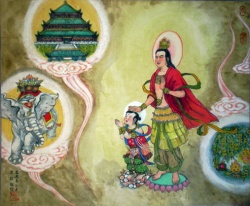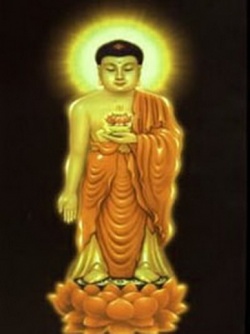Buddhism and Semiotics by Fabio Rambelli
Buddhist thought conceives of language as the main tool to build and articulate phenomenal reality. The fourth ring in the chain of conditioned causation (pratitya-samutpada), nama-rupa, represents the inextricable interdependence of cognitive processes and external reality, phenomena and discriminating mind, names and things of the ordinary world of suffering.
Linguistic descriptions of the world have no absolute truth value; language is an instrument of fallacious knowledge, because it creates the reality perceived in ordinary states of consciousness, through the Categorization and conceptualization of perceptual data and their semantic articulation.
Ordinary yogacara epistemology, which takes the shape of a radical constructivism, attributes to language the function of articulating a world of illusion through the power of semiotic "seeds" (bija). Non-enlightened people consider their own ordinary image of the world to be true and corresponding to reality, since they attribute to the objects the characteristics peculiar to linguistic expressions (autonomy, immutability, homogeneity).
This kind of confusion of ontology with epistemology, of reality with its linguistic descriptions and mental images is called avidya, "ignorance". Epistemologic ignorance is the first cause of existential suffering. Therefore, there is an absolute hiatus separating language from true reality. The tradition of the great Indian philosopher Nagarjuna (ca. 150-250 A.D.), in particular, systematically developed this philosophical position.
According to a well established traditional doctrine, quoted in some Buddhist sutras, the words of ordinary language are (i) related to superficial aspects of phenomena, (ii) uttered in dreams (iii) conditioned by fallacious attachment to wrong ideas, (iv) forever conditioned by the seeds of suffering.
Being this the case, Buddhist linguistic speculation had to face the question of the status of the word of the Buddha. Did the Buddha contribute to sentient beings' suffering and illusion speaking words devoid of truth?
As one can easily understand, this was not just a pedantic disquisition on the edges of philosophy of language. On the contrary, doctrinal matters of pedagogy, epistemology and soteriology were at stake here, affecting also speculations on the nature of the Buddha and the status of his historical and provisional manifestations.
Obviously, it was not possible to completely deny the value of the word of the Buddha, because this would have meant the self-destruction of Buddhism. Instead, a distinction was made between the wisdom of the Buddha and the signs conveying it, and the word of the Buddha was given a peculiar status. Texts like the Diamond Sutra (Vajracchedika Prajnaparamita Sutra), the Vimalakirti Nirdesa Sutra, or the Lankavatara Sutra sanction in an inevitably paradoxical way the ineffability in human ordinary language of the wisdom of the Buddha.
This sanction of ineffability can be interpreted in two ways, both very interesting for the semiotician: i) the Buddha does not speak, and conveys his experience in a non-linguistic way, because communication through language is not possible; this view was later developed in particular by some chan and zen radical currents, which rigorously attempted to deconstruct and dissolve every semiotic practice; ii) the Buddha, on the basis of his states of consciousness, uses a peculiar language consisting in special systems of signs, which is possible to know and understand.
These opposite positions both presuppose a theory of communication and a semiotics of initiatory transmission of meaning. Despite doctrinal differences, all Buddhist traditions in fact agree with some basic hermeneutical assumptions, according to which the Buddha explained many different doctrines in consideration of circumstances and contexts of speech, and competence and salvational needs of the audience.
The first sanction of ineffability (communication through language is impossible) was developed by the tradition ascending back to Nagarjuna, aimed at the attainment of the Emptiness through the incessant deconstruction of assumptions, concepts, meaningful practices.
The second option (the Buddha speaks a different, higher kind of language) could yield on its turn to two different interpretations: (a) the language of the Buddha is a mere upaya, a skilful means, an expedient devoid of absolute value but necessary in order to help the humans to attain a truth transcending every language: this is the doctrinal position of most Buddhist schools; (b) absolute truth can be communicated, and the Buddha speaks peculiar words of a non-ordinary language in order to lead sentient beings to salvation: this is the basic assumption of the teachings of esoteric Buddhism.
In both cases, a systematic manipulation of linguistic signs was put into practice, in order to bring language beyond its limits, and force it to speak the absolute.
How is communication explained by Buddhism? What are the characteristics of signs? What are their status and functions? In which ways does semiosis - the cultural practice of creation and interpretation of signs, and transmission of knowledge -occur? And further: which are the strategies concerning the discursive transposition of Buddhist religious experience? What kind of relationship connects cosmology, ontology, soteriology, and semiotic concepts and practices within the Buddhist episteme? All these questions are relevant both to general semiotics as a theoretical discipline and a philosophical activity, and to the interpretation of cultures in which Buddhism developed as well, since Buddhist philosophical reflection on sign and the related practices probably constituted their predominant semiotic paradigm (or, at least, part of it) for many centuries.
An organic and systematic study of Buddhist semiotics is still to undertake. Until now, only a few scholars tackled aspects of Buddhist cultures with a semiotic eye: among them Allan Grapard, Stanley Tambiah, Alexander Piatigorsky, Gregory Schopen.
Buddhist semiotic ideas and practices show many differences, for they developed in a wide variety of cultural, historical, and social contexts. Buddhism established two basically different kinds of semiotics: one related to what could be called ordinary semiosis, another to describe the interactions with reality in altered (meditative) states of consciousness. Only the most basic elements of Buddhist semiotics, common to a large part of the Buddhist universe of discourse, will be outlined here.
One of the most striking characteristics of the Buddhist Canon is its heterogeneity; even the doctrines traditionally attributed to the teaching of the historical Buddha are often in overt contradiction. The Buddhists gave such doctrinal heterogeneity a pragmatic and communicational meaning. One of the core of Buddhism, in fact, is that the Buddha taught many different doctrines according to his audience's faculties and possibilities of comprehension. This is in accordance with Indian cosmology and psychology, which recognize various levels of existence and stages in the development of consciousness: a certain truth and a certain set of doctrines correspond to each one. Therefore, Buddhist exegesis presupposes some interesting points for the semiotician: different levels of truth, and a semiotics of textual cooperation.
In mahayana Buddhism the Buddha is no longer simply a historical person, the teacher, the Enlightened One, but is transformed into a manifestation of the universal principle of enlightenment, a silent, eternal, numinous presence, called Dharmakaya ("the body of the Dharma"). This buddhologic transformation made the Universal Buddha the ultimate subject of all discourses, the universal principle of articulation of discursivity. This is shown in many texts, where the Buddha says nothing until the epilogue, but silently empowers the characters of the text to ask and answer, thus revealing themselves certain difficult doctrines.
Perhaps the most influential Buddhist model of semiosis was developed within the Indian yogacara epistemologic tradition by Asanga (IV century), Vasubandhu (IV-V century), and later by Indian, Chinese, Korean, Japanese, and Tibetan monks. The principle of this school was very subtle and complicated, its basic tenets can be outlined as follows:
According to yogacara epistemology, semiosis (and knowledge) is a complex process of interaction between various levels and functions of mind with a supposedly outside world through the mediation of senses. Each one of the six sense organs (sight, hearing, taste, smell, touch, intellect) perceives qualities among six perceptual fields in the outside world (forms, sounds, flavours, perfumes, tactile qualities, the thinkable). Perceptual data of direct experience (preceding the attribution of a name) are further elaborated by six sense consciousness corresponding to each of the six sense organs; in particular, the sixth consciousness unifies the data, attributes names and formulates judgements.
These six superficial consciousness are based on another consciousness, called mano-vijnana which is the centre of the l-consciousness, creating the distinction between subject and object. But all this process is possible because of the existence of a still deeper consciousness, the alaya-vijnana, store of sign-seeds, acting recursively on perception and volition, on the interaction of mind with the world.
Alaya-vijnana has been usually described as Western commentators as the unconscious, but it would be perhaps more accurate to rather consider it as the mental centre of semiosis. It contains the seeds of all perceptions, objects, thoughts, deeds, volitions; the past experiences influence the future ones, and the future experiences reorganize the deposit of seeds. In this way, time and karma have a semiotic foundation.
The basic tenet of yogacara epistemology is that only mind exists, and the world is the result of the articulating activity of the mind (vijriapti-matrata). The image that a person has of the ordinary world is nothing else than a transformation of alaya-vijnana. External reality is non existent, because the objects appearing to ordinary beings are created by consciousness through a complex work of articulation and organization.
Usually described as a form of idealism, this view seems rather to be closer to constructivism. In any case, it should be remembered that according to the yogacara school, also mind and consciousness are non-existent, from the point of view of the enlightened one, and everything is not different from Emptiness, at the same time semiotic potentiality and mirror-like quiescence.
Yogacara semiotics posits two different kinds of signs: signs as characteristics of the objects (laksa na and nimitta), and signs as cognitive and passional potentialities stored in alaya-vijnana (bija).
Laksa na is the name of signs characterizing the essence of things (such as the thirty-two marvellous marks of the Buddha-body), and has positive overtones. Nimitta are superficial, external characteristics of things.
The power of alaya-vijnana to create all things is compared with the generative power of seeds. Actually, the power of alaya-vijnana depends on the existence of semiotic seeds called bija. Two kinds of bijas can be detected: (i) linguistic and karmic seeds: phenomenal existence of subject and the outside world closely related to the language which articulates it; linguistic seeds sown by good or bad actions are called karmic seeds, and affect the subject's becoming; (ii) innate bijas (like the seeds to become a Buddha), and newly produced bijas (seeds sown after experience).
Seeds produce the phenomenal world, but at the same time the phenomenal world affects alaya-vijnana, sowing new seeds. Production of new bijas depends on perceptual and cognitive contact with laksa nas, nimittas; but at the same time, recognition of objects consists of the identification of laksa nas and nimittas through bijas stored in alaya-vijnana.
The production of new seeds is called "perfuming" (vasana, abhyasa, bhavana). As a strong perfume lingers on a dress, so the impressions of experienced things remain in the consciousness and affect mind and body. The cognitive and affective contents of phenomena, through the power of karma, perfumes the knower's alaya-vijnana, thus producing new bijas, which on turn give rise to phenomena again. This recursive circuit of subject and object generates the ordinary world. Thus semiosis, as the discriminatory process articulating the world, is the cause of ignorance, attachment, illusion, and suffering.
Once human cognitive apparatus has been transformed, once alaya-vijnana has been switched into the supreme mirror-like wisdom, semiosis (as the activity of creation, interpretation and transmission of signs :s brought to an end by the attainment of Emptiness. What remains is only the reiteration of cosmic processes and the reflection of the absolute and undifferentiated World of the Dharma, performed through yoga. Buddhist texts describe this situation defying human possibilities of comprehension through the metaphor of Indra's Net: each pearl reflects all the other pearls, without interpreting or modifying them. The Buddhist universe in its absolute modality is made of reflections reflecting reflections, in a cosmic interplay of pure light.
Since the late 1970s Buddhist concepts and metaphors are more and more frequently found in semiotic discourses. It is less a systematic phenomenon than a transversal attitude fragmented in scattered texts and in the usage of many authors. Nonetheless, these different instances of penetration of Buddhism share their recurrence in the general ambit of the new cognitive sciences -- constructivism, cognitivism, science of complexity, Artificial Intelligence -- in which traditional boundaries between hard and human sciences, between physics, biology, psychology, and semiotic disciplines are blurred.
Although fragmentary and in many aspects still superficial, the usage of Buddhist concepts in semiotic discourses is not a mere academic fashion, but it is rather a significant symptom of the present situation of scientific research. New Sciences, after having broken up with the tradition of modern science with its dualistic postulates, must create new models of reality and new descriptions of the world in order to establish themselves. And it is very significant that many authors are more and more explicitly resorting to Buddhism (and not just to the superficial category of so-called Oriental thought) in their search for new metaphors and concepts.
Roland Barthes was perhaps the first to introduce in semiotics Japanese Buddhist concepts such as Ku (Emptiness) and Satori (Enlightenment). Although in a very simplified form, these concepts mediated from Zen Buddhism entered Barthes' own personal semiotic discourse, aimed at bringing language to a stop, in search for the degree-zero of semiotics. Barthes' very peculiar interpretation of the Empire of signs has had an enormous impact in Japan. And despite all the shortcomings of this work, Barthes has contributed to reveal the existence of semiotic problematics in concepts like Emptiness and Satori, usually interpreted only from a religious point of view.
Buddhism has been associated also with the practices of deconstruction. In particular, some scholars have been struck by methodological affinities in the treatment of language by Jacques Derrida and the Indian philosopher Nagarjuna (11-111 century). Robert Magliola has shown how the study of Buddhist deconstructionist doctrines can be useful also for the creation of a post-modern Christian theology.
In an extremely interesting and convincing way Douglas Hofstadter used Zen Buddhism as a paradoxical tool to solve logical aporias related to systemic recursiveness and to formulate hypotheses on the problem of mind and consciousness.
Buddhist metaphors and concepts appear to be important for the development of a new epistemological paradigm. For instance, the cosmology of new science is often described through metaphors drawn from Oriental thought, after the groundbreaking work of Fritjof Capra.
Criticism of classical ideas of rationality and the study of different cognitive modalities (Matte Blanco, Morin) might have at their basis an awareness of Indian yoga and of an important part of Buddhist thought. According to Matte Blanco, for instance, there are two ways to understand the world: one is asymmetrical and dividing, the other is symmetrical and unifying. This is very close to Buddhist psychological and epistemological theories.
Humberto Maturana and Francisco Varela, the authors of a radical and semiotically grounded theory of living entities, stress the continuity of knowledge with perceptive and biological structures of beings. Their recursive theory of knowledge is significantly similar to Buddhist yogacara epistemology, although they never mention it.
Floyd Merrel, with Charles Peirce's theme of unlimited semiosis as a starting point, attempts to outline a theory of semiotics suitable to the cosmology of new science. According to Merrell, who describes the cosmos as an incessant semiotic flow, there is no way to talk about "objective reality", because everything that exists in our world "can be no more than semiotic ally real" (Merrell: x). To sketch his semiotic cosmology, Merrell resorts also to Buddhist metaphors and concepts, such as Emptiness and Indra's Net.
Francisco Varela quotes extensively works from Confucian, Taoist, and Buddhist traditions in a recent series of lectures aimed at proposing a project of ethics for the new society. According to Varela, Buddhist doctrines of no-self and nondualism can offer and interesting contribution in dialogue with computer science. For instance, the doctrine of no-self can help to understand the fragmentation of the self operated by cognitivism and connectionism; Buddhist non-dualism especially that of Nagarjuna's tradition, can be placed side by side to the conceptions of Merleau- Ponty and also to the more recent ideas on Knowledge as enaction.
Penetration of Buddhism into semiotics. epistemology, ethics is by no means a surprise. Actually, during the last two decades Buddhism has been taking roots in western countries and flourishing as an autonomous tradition. This is perhaps similar to what happened many centuries ago in China and in the other countries of the Far^East and South-East Asia. when many forms of Buddhism spread and started to interact with those cultures producing new and richer ideas and practices.
References Alper, Harvey P., ed., Mantra. Albany: State University of New York Press,1989.
Barthes, Roland, L'empire des signets Geneve: Skira - Paris: Flammarion,1970.
Capra, Fritiof, The Tao of Physics. Berkeley: Shambhala,1975.
Conze, Edward, ed., Buddhist Wisdom Books. The Diamond and the Heart Sutra. London: Unwin,1958 (rev.ed.1988)
Gomez, Luis O., "Buddhist Literature: Exegesis and Hermeneutics", in Mircea Eliade, ed., Encyclopedia of Religion. Vol.2. New York: MacMillan,1987: 529-540.
Gomez. Luis O., "Buddhist Views of Language". Encyclopedia of Religion. Vol. 8. New York: MacMillan,1987: 446-451.
Grapard, Allan, The Protocol of Gods. Berkeley-Los Angeles- London: California University Press.
Grapard, Allan G., "Linguistic Cubism. A Singularity of Pluralism in the Sanno Cult", Japanese Journal of Religious Studies 14/3 (1987): 211-234.
Hakeda, Yoshito Kukai. Major Works. New York: Columbia University Press,1972.
Lopez, Donald S., Jr., ed., Buddhist Hermeneutics (Kuroda Institute Studies in East Asian Buddhism 6). Honolulu: University of Hawaii Press,1988.
Maturana, Humberto, and Varela, Francisco. Autopoiesis and Cognition: The Realization of the Living. Dordrecht: D. Reidel 1980.
Merrel, Floyd. Signs Becoming Signs. Bloomington and Indianapolis: Indiana University Press,1991.
Murti, T. R. V., The Central Philosophy of Buddhism. London: Unwin,1955 (reprint 1987).
Piatigorsky, Alexander, and Zilberman, D.B., "The Emergence of Semiotics in India", Semiotica 17:3 (1976): 255-265.
Piatigorsky, Alexander, The Buddhist Philosophy of Thought. London and Dublin: Curzon Press, and Totowa, NJ: Barnes & Nobles Books,1984.
Suzuki D. T., ed. The Lankavatara Sutra. London: Routledge, 1932.
Tambiah, Stanley J., Buddhism and the Spirit Cults in North- east Thailand. Cambridge: Cambridge University Press, 1970.
Tsuda Shin'ichi, "A Critical Tantrism", Memoirs of the Toyo Bunko 36.1978: 167-231.





